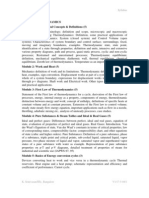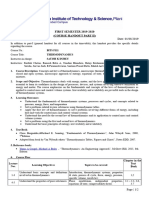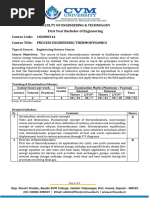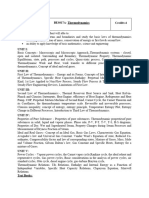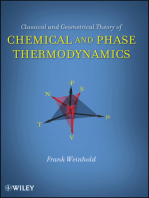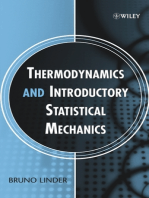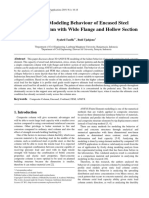Thermal Science 2nd
Thermal Science 2nd
Uploaded by
Syh TfkCopyright:
Available Formats
Thermal Science 2nd
Thermal Science 2nd
Uploaded by
Syh TfkOriginal Title
Copyright
Available Formats
Share this document
Did you find this document useful?
Is this content inappropriate?
Copyright:
Available Formats
Thermal Science 2nd
Thermal Science 2nd
Uploaded by
Syh TfkCopyright:
Available Formats
Fuzhou University
Subject name Thermal Science
Subject code 00500992
Status Major
Teaching hours 40 lecture, 26 tutorial
Semester/Year
Pre-requisite
Teaching method Lectures & Tutorials
Assessment Assignments and Tutorials 10%
Term test 1 20%
Term test 2 20%
Exams (Open Text Book) 50%
Lecturer
Objective and Objective:
Learning Topics covered include fundamental concepts in thermodynamics, properties
outcomes of a pure substance, boundary work, first law of thermodynamics for closed
and open system, second law of thermodynamics and engineering applications
of thermodynamics.
Learning outcomes:
1. Understand the basic concepts of thermal and mechanical equilibrium, and
apply the basic hydrostatics principles to simple engineering problems.
2. Determine the thermodynamic properties of a pure substance, and
evaluate a thermodynamic process involving phase changes.
3. Understand the derivation of the general mass and energy conservation
equations.
4. Analyze and solve open and closed system problems that involve mass,
heat and work transfer for thermodynamic processes involving pure
substances and ideal gases.
5. Apply the second law of thermodynamics to cycles and cyclic devices.
6. Use a systematic problem solving technique to solve thermodynamic
problems.
Syllabus & 1. Basic Concepts.
Course Content Thermodynamic System and the Control Volume, Macroscopic Versus
Microscopic Point of View, Properties and State of a Substance, Processes
and Cycles, Units for Mass, Length, Time, and Force, Energy, Specific
Volume and Density, Pressure, Equality of Temperature, The Zeroth Law
of Thermodynamics, Temperature Scales
2. Properties of a pure substance.
The Pure Substance, Vapor-Liquid-Solid-Phase Equilibrium in a Pure
Substance, Independent Properties of a Pure Substance, Tables of
Thermodynamic Properties, Thermodynamic Surfaces, The P–V–T
Behavior of Low- and Moderate-Density Gases, P-v and T-v diagrams,
applications
3. Work and Heat.
Fuzhou University
Definition of Work, Units for Work, Work Done at the Moving Boundary
of a Simple Compressible System, Other Systems that Involve Work,
Concluding Remarks Regarding Work, Definition of Heat, Heat Transfer
Modes, Comparison of Heat and Work, Engineering Applications
4. First law for closed and open systems.
The First Law of Thermodynamics for a Control Mass Undergoing a
Cycle, The First Law of Thermodynamics for a Change in State of a
Control Mass, Internal Energy—A Thermodynamic Property, Problem
Analysis and Solution Technique, The Thermodynamic Property Enthalpy,
The Constant-Volume and Constant-Pressure Specific Heats, The Internal
Energy, Enthalpy, and Specific Heat of Ideal Gases, The First Law as a
Rate Equation, Conservation of Mass, Engineering Applications
5. First Law Analysis for a Control Volume
Conservation of Mass and the Control Volume, The First Law of
Thermodynamics for a Control Volume, The Steady-State Process,
Examples of Steady-State Processes, Engineering Applications
6. Second law.
Heat Engines and Refrigerators, The Second Law of Thermodynamics,
The Reversible Process, Factors that Render Processes Irreversible, The
Carnot Cycle, Two Propositions Regarding the Efficiency of a Carnot
Cycle, The Thermodynamic Temperature Scale, The Ideal-Gas
Temperature Scale, Ideal versus Real Machines, Engineering Applications
Total hours 48 class hours
Textbook Borgnakke and Sonntag, Fundamentals of Thermodynamics, 8th edition.
You might also like
- Thermodynamics Syllabus (Proposed 24-25)No ratings yetThermodynamics Syllabus (Proposed 24-25)3 pages
- Thermodynamics and Combustion: Fundamental Concepts of ThermodynamicsNo ratings yetThermodynamics and Combustion: Fundamental Concepts of Thermodynamics3 pages
- Birla Institute of Technology and Science, Pilani: Pilani Campus AUGS/AGSR DivisionNo ratings yetBirla Institute of Technology and Science, Pilani: Pilani Campus AUGS/AGSR Division6 pages
- BITS F111 Thermodynamics Handout 2014-15No ratings yetBITS F111 Thermodynamics Handout 2014-152 pages
- Sessional - 100 100 Final - Total - 100 100No ratings yetSessional - 100 100 Final - Total - 100 1003 pages
- Course Objectives:: Course Title: Course No.: InstructorNo ratings yetCourse Objectives:: Course Title: Course No.: Instructor2 pages
- BITS F111 Thermodynamics Handout 2013-14No ratings yetBITS F111 Thermodynamics Handout 2013-142 pages
- Faculty of Engineering & Technology First Year Bachelor of Engineering Course Code: 102000214 Course Title: Process Engineering ThermodynamicsNo ratings yetFaculty of Engineering & Technology First Year Bachelor of Engineering Course Code: 102000214 Course Title: Process Engineering Thermodynamics3 pages
- Bmee203l Engineering-Thermodynamics TH 1.0 70 Bmee203lNo ratings yetBmee203l Engineering-Thermodynamics TH 1.0 70 Bmee203l2 pages
- Fundamentals of Thermodynamics and Heat TransferNo ratings yetFundamentals of Thermodynamics and Heat Transfer4 pages
- Ch6402 Chemical Engineering Thermodynamics-I L T P C3 0 0 3 ObjectiveNo ratings yetCh6402 Chemical Engineering Thermodynamics-I L T P C3 0 0 3 Objective1 page
- Ase2012 Thermodynamics-For-Aerospace-Engineering Lt 1.0 21 Ase2012 Thermodynamics-For-Aerospace-Engineering Lt 1.0 1 Thermodynamics for Aerospace EngineeringNo ratings yetAse2012 Thermodynamics-For-Aerospace-Engineering Lt 1.0 21 Ase2012 Thermodynamics-For-Aerospace-Engineering Lt 1.0 1 Thermodynamics for Aerospace Engineering2 pages
- Bmee203l Engineering-Thermodynamics TH 1.0 67 Bmee203lNo ratings yetBmee203l Engineering-Thermodynamics TH 1.0 67 Bmee203l3 pages
- “Foundations to Flight: Mastering Physics from Curiosity to Confidence: Cipher 4”: “Foundations to Flight: Mastering Physics from Curiosity to Confidence, #4From Everand“Foundations to Flight: Mastering Physics from Curiosity to Confidence: Cipher 4”: “Foundations to Flight: Mastering Physics from Curiosity to Confidence, #45/5 (1)
- Classical and Geometrical Theory of Chemical and Phase ThermodynamicsFrom EverandClassical and Geometrical Theory of Chemical and Phase ThermodynamicsNo ratings yet
- The Thermodynamic Universe and Beyond: How Nature's Laws Reveal the Secrets of Time, Biology, Information, and Quantum RealityFrom EverandThe Thermodynamic Universe and Beyond: How Nature's Laws Reveal the Secrets of Time, Biology, Information, and Quantum RealityNo ratings yet
- Treatise on Irreversible and Statistical Thermodynamics: An Introduction to Nonclassical ThermodynamicsFrom EverandTreatise on Irreversible and Statistical Thermodynamics: An Introduction to Nonclassical ThermodynamicsNo ratings yet
- PBSJASCEStructuresCongress- Curved Prestresed BridgeNo ratings yetPBSJASCEStructuresCongress- Curved Prestresed Bridge25 pages
- Outline and Features of Special Program of Engineering Science 21st CenturyNo ratings yetOutline and Features of Special Program of Engineering Science 21st Century9 pages
- Size Effects in Reinforced Concrete Beams StrengthNo ratings yetSize Effects in Reinforced Concrete Beams Strength6 pages
- UAS Jan 2022 - Analisa Struktur 1 - ISTNNo ratings yetUAS Jan 2022 - Analisa Struktur 1 - ISTN2 pages
- Integrated Urban Infrastructure and Service100% (2)Integrated Urban Infrastructure and Service99 pages
- Nilai Perbandingan Beban Dan Deformasi Hasil Analisis ANSYS ED 9.0No ratings yetNilai Perbandingan Beban Dan Deformasi Hasil Analisis ANSYS ED 9.06 pages
- Pokhara-University-Syllabus-Thermal ScienceNo ratings yetPokhara-University-Syllabus-Thermal Science4 pages
- Chapter 2 Tension, Compression and ShearNo ratings yetChapter 2 Tension, Compression and Shear3 pages
- Probability and Statistics: Rusdianto Roestam PHDNo ratings yetProbability and Statistics: Rusdianto Roestam PHD28 pages
- Final Grade 20183 012201600015 Fiqa Nadhira Luthfia Taufik 12767 PDFNo ratings yetFinal Grade 20183 012201600015 Fiqa Nadhira Luthfia Taufik 12767 PDF1 page
- Table: Joint Reactions Joint Outputcase Casetype F1 F2 F3 M1 M2No ratings yetTable: Joint Reactions Joint Outputcase Casetype F1 F2 F3 M1 M233 pages
- HVAC Terms: Definition of Some Common HVAC Industry Terms - Absolute Humidity, Pressure, Temperature and MoreNo ratings yetHVAC Terms: Definition of Some Common HVAC Industry Terms - Absolute Humidity, Pressure, Temperature and More6 pages
- Exercise 1 - Abiotic Factors (RAMOS - BI7B)No ratings yetExercise 1 - Abiotic Factors (RAMOS - BI7B)9 pages
- I. Multiple Choice. Write The Best Answer From The Following Choices100% (1)I. Multiple Choice. Write The Best Answer From The Following Choices5 pages
- Expansion Joint For Steel Building: Increase Decrease DecreaseNo ratings yetExpansion Joint For Steel Building: Increase Decrease Decrease4 pages
- Stoecker Jones - Refrigeration Air Conditioning 2nd Ed PDF100% (1)Stoecker Jones - Refrigeration Air Conditioning 2nd Ed PDF440 pages
- Auto-Abel Flash Point Tester 34200-2: IP 170 IP 492 BS 3900-A9 & BS 6664-2 & ISO 1523 BS EN ISO 13736 & BS 2000-170No ratings yetAuto-Abel Flash Point Tester 34200-2: IP 170 IP 492 BS 3900-A9 & BS 6664-2 & ISO 1523 BS EN ISO 13736 & BS 2000-1701 page
- Vapour-Liquid Equilibria of Nitric Acid-Water-Sulphuric Acid MixturesNo ratings yetVapour-Liquid Equilibria of Nitric Acid-Water-Sulphuric Acid Mixtures9 pages
- Practice Problems On First Law For Closed SystemNo ratings yetPractice Problems On First Law For Closed System3 pages

















